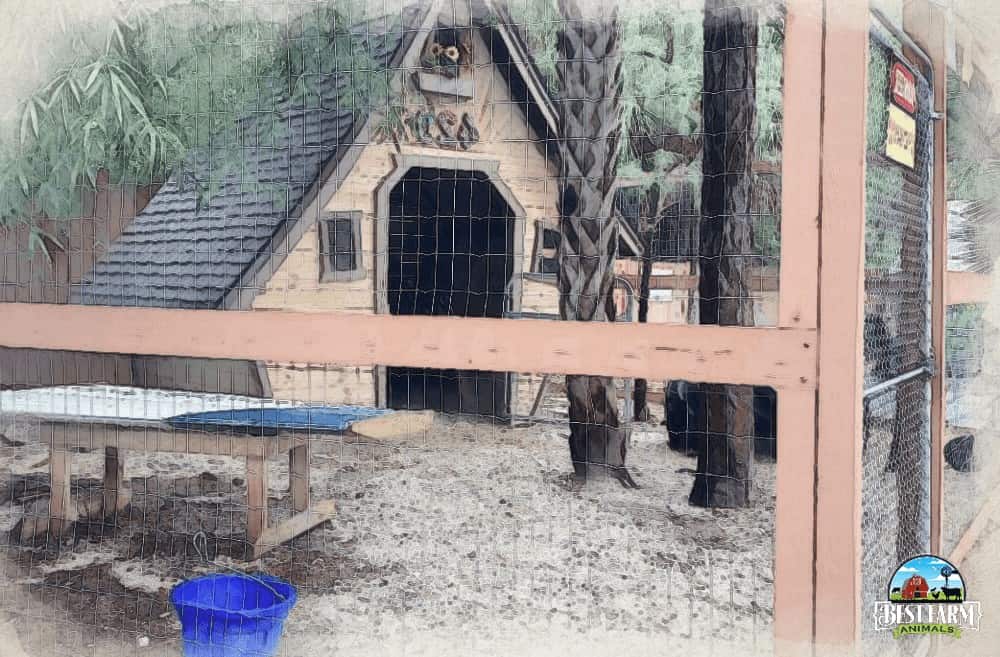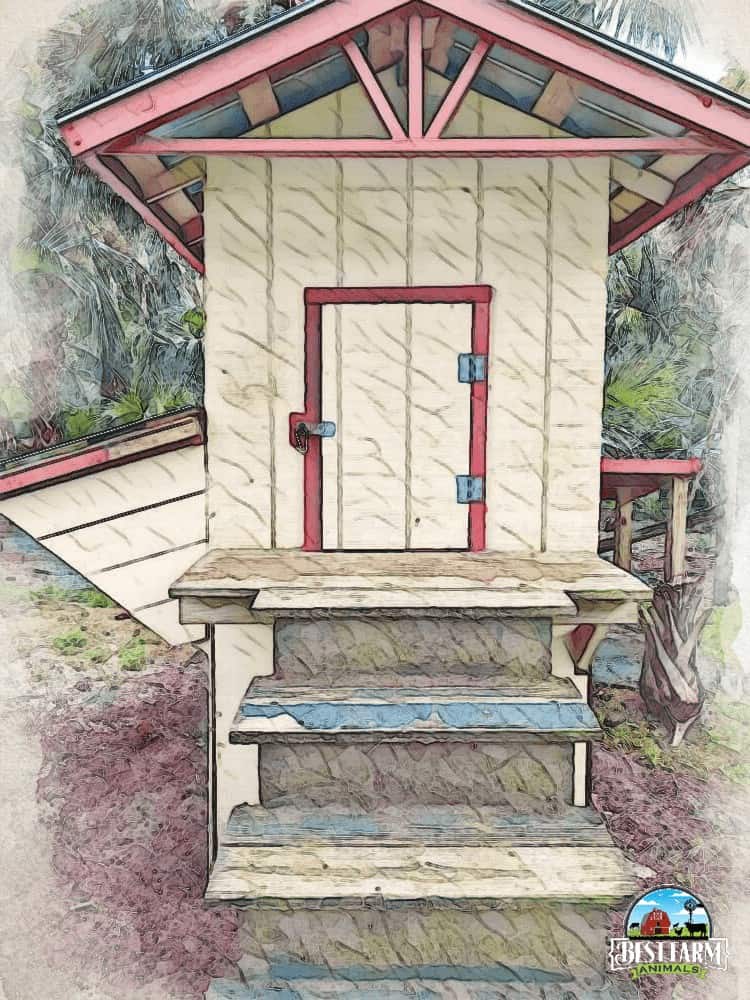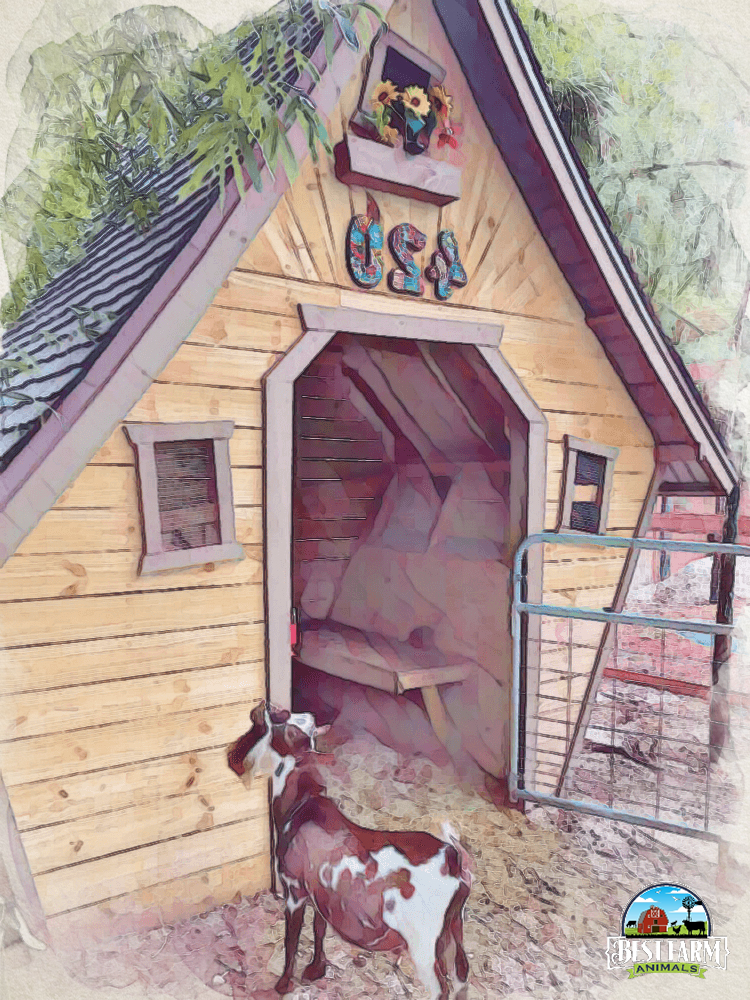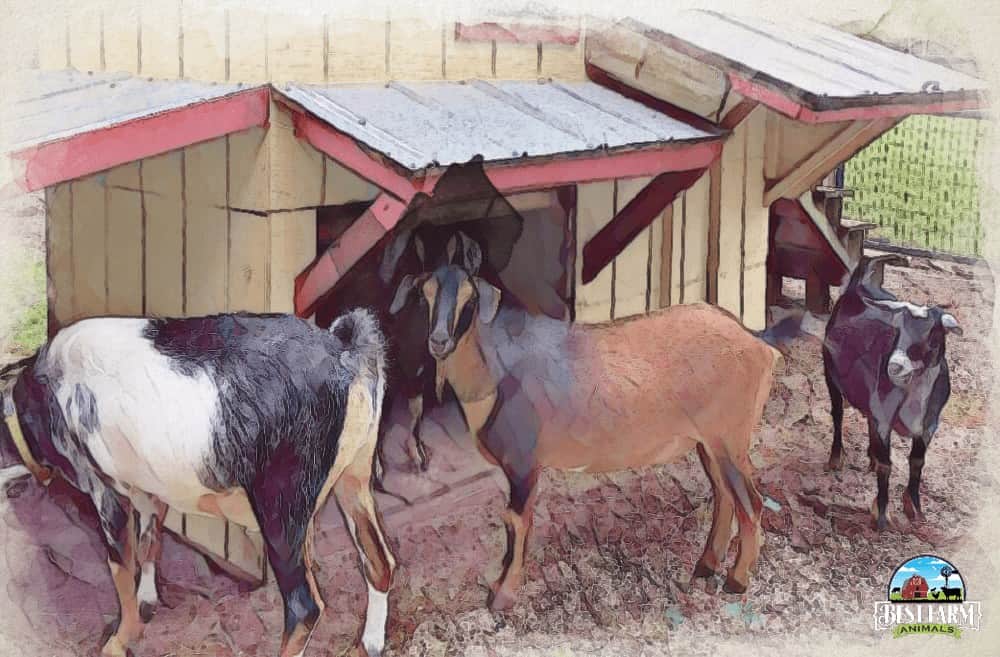
Rule number one when raising goats is keeping them safe, which is hard to do at night when many predators prowl about, and you’re most likely sound asleep.
Goats require only a small amount of sleep (just over five hours a day), and they can see relatively well at night, even in low light (thanks to their rectangular pupils), so they are active at night when you’re not around.
Should you lock in goats at night? Goats should always be locked up at night or secure in fencing that keeps out predators. Goats need protection from predators, which a goat house can provide, but so can an exterior electric fence or secure fencing. In addition to a secure area that I lock my goats in at night, I also have a motion light that turns on so if a predator comes near- they are scared away.
Should You Lock Goats at Night?
Locking up your goats at night is a good practice to protect your farm animals. Goats sleep at night for an average of five hours. Interestingly, goats have excellent vision and can see potential predators even when dark. Thus, closing them at night up keeps your goats safe from predators.
Bottomline is goats need shelter, whether it’s at night, in the morning, or if it’s raining. Goats cannot sleep or stay outside at night for their safety. Also, a goat house should be spacious enough for goats to explore and play.
How to Keep Goats Safe From Predators?
I polled over 300 goat owners and discovered that almost 60% of goat owners lock their goats up at night. 40% do not. The reasons may surprise you.

Here are five of the most frequently used goat protection options, ordered from what I consider the most important to the least optimal level of protection. You can decide which (or which combination) is best for you.
- Fencing: Good fences are the absolute key to keeping your goats safe. Most goat keepers combine a woven wire fence with electric fencing, though solely one or the other can work as well if installed correctly.
- Livestock Guardian Dogs: The most reliable protection for your goats is likely to be a Livestock Guardian Dog (LGD). These dogs have been bred specifically for this purpose, so most of them have strong instincts to protect their charges on your farm.
- Housing: All goats need shelter from inclement weather. If the predator load is high in your area and your fencing is less than ideal, a lockable goat house or a pole barn that you can close and lock at night is a great option.
- Guardian Livestock Kept with Goats: Donkeys and dogs are natural enemies. Most full-sized jacks and jennies would love the opportunity to crush a coyote. Other animals such as horses, llamas, and even emus may also keep predators at bay.
- Herd Size and Natural Goat Protection: Some experienced goat keepers trust the size of their goats, goatherd, and the goats’ natural protection–their horns and eyes.
First Goat Protection Option: Fencing
Fencing is expensive but necessary to keep your goats in and to discourage uninvited after-hours visits. Some goat keepers find that it’s not needed to lock goats into an enclosure at night with adequate fencing. Keyword: good fencing.
If your budget is tight, rather than fencing in your entire pasture with a predator-proof fence, you can create a night pen for your goats. Using optimal fencing materials, you should build this night pen around your goats’ shelter so they can get out of the elements at night. The night-pen should be open during the day to allow your goats to forage.
Having tried several fence methods (and found that goats are incredible escape artists), I recommend the following types organized from my favorite to my least favorite.

Electric Fencing (High Tensile Electric Fence)
Electric tensile fencing uses many strands of wire, each electrifying. I love electric fencing because I can cheaply pen in my goats over a large space. Tensile means it is stretched tightly for durability. It’s better than barbed wire because it’s convenient and not expensive initially.
Electric fencing requires almost no maintenance through the summer, but it does require regular checks during the winter when the soil is dry, and animals’ winter coats are thick. It may require additional voltage for adequate protection.
Cons of an Electric Fence
Electric fences are most effective when the goats have been training from a young age. Just this last fall I had bucks get out to reach the does. If a goat is determined enough- it can get out. But for larger area- electric fencing is the cheapest fencing.
In addition, weeds and branches along the fence line must be trimmed, or the strength of the shock diminishes. Installing and maintaining an electric fence along a row of trees or plentiful weeds is inconvenient.
And like the barbed wire option, you should string it with more lines than required for larger livestock to be sure your goats don’t slip through the fence lines. It would be harrowing for a goat to get stuck in an electric fence.
This winter, which had much more snow than usual, I had to bring my goats into a smaller space with cattle panels because the electric fence was shorting out from the 3-5 feet high snow drifts.
Portable Electric Netting
Next, I prefer portable electric netting. I got mine from premier1.com. My portable fence moves and takes about 15-20 minutes to take down and set up. I use the portable fence for the small patches and awkward areas of my field and yard.
I like moving my goats around the field relatively quickly, letting certain areas rest, and offering my goats various grazing options. And because I don’t need much of it, it is cost-effective.
And keep in mind that whichever fence option you choose, it should reach at least 5-6 feet high to keep your goats in and discourage predation. Ideally, you can fence your entire property. Still, remember that most perimeter fences will not fully protect your goats from predators.
Hog Panels
Hog panels come in 3rd place because of their cost and difficulty moving them. Hog panels come in 16-foot lengths. They range from $39.99 for a 42” high panel to $44.99 for a 56” tall panel at the Tractor Supply Store where I live. There is a 34” high option for $28.99/panel. That may suffice for pregnant does and kids, but it is not high enough to keep your standard-sized goats enclosed.
For about $160 (plus the cost of the posts), you could buy four hog panels and create a 16’ x16’ square enclosure (appropriate for about two goats). But your goats would need additional feed supplements or be moved nearly daily to provide them sufficient nutrition. To move a hog panel, you’d have to install T-posts and be willing to spend a lot of time every day moving unwieldy panels.

Woven Field Fence
Woven field fence is another option that I’ve used. It is easy to set up, comes in various sizes, and is durable when installed properly.
The smaller holes of the 2” x 4” field fence are a safer bet for a horned goat. I didn’t think of that and got the larger holes. As a result- I had to help our goats extradite themselves from the fence until they learned how to turn their heads and get unstuck from an occasional horn stuck in a fence.
I use field fencing around my goats’ night housing. Eventually, I added a strand of electric tensile wire along the top as my goats jumped on it and rubbed against it all day. The wear tended to sag the fence after only a few months. The electric fence line solved that problem.
The biggest issue with woven field fence is that it will stretch and sag with time. Goats love to rub against things. It will need to be stretched annually and it can be a pain to stretch woven field fence and it will take at least two people. (It’s easier to patch electric fences- which I can do alone).
Barbed Wire
Barbed wire is my least favorite option. It is commonly used on farms, so it is widely available, not challenging to install, and not costly. However, attempting to keep goats in a barbed-wire fence requires you to string more wires (especially down low) than you would use for other livestock.
Stringing more wires is more work and costly, so the cost efficiency and ease of installation are diminished. The risk of injury is also higher than with other forms of fencing.
Second Goat Protection Consideration: LGDs
Except for the essential requirement of good fencing for your goats, the best form of protection for your herd is Livestock Guardian Dogs (LGDs). There are many breeds of LGDs, so be sure to research the species that will work best in your location and your needs.
Our newborn goats lived inside and on our porch for their first 3-4 weeks but eventually had to head out to the great unknown. About that time, some neighbors of ours lost a mini donkey to a panther in the late afternoon.
We already locked up our kids at night, but now we became concerned about them during the day when we weren’t home. Since we already had a solid perimeter fence and a goat house, we found a pair of young Anatolian Shepherds. Anatolian Shepherds are Livestock Guardian Dogs that have been bred for several millennia in Turkey to protect vast herds of goats and sheep.
LGDs work best in pairs. Depending on the size of your farm and the number of livestock, you may need more than two. But you are unlikely to find a more reliable source of protection for your herd. The dogs’ bark alone keeps most animals at bay.
And the few hungry critters who have accidentally wandered onto our property have not been left alive. If you’re willing to take the time and financial investment, they are well worth the effort to protect your goats.
We no longer need to lock our goats anywhere at night. We feel confident that our goats are entirely safe between our woven wire fencing (topped with electric wires), the fencing around their night pen, and our LGDs. Many other goat owners shared this sentiment.
Third Goat Protection Consideration: Housing
All goats need access to shelter from inclement weather; you can also use this for night protection. A closed pole barn or lockable goat house is a great solution to provide weather and predator protection. It is my third favorite option because locking a large herd into a barn may be difficult every night.
There is little my goats hate more than getting wet, and living in South Florida. They have to face summer storms almost every day from May through September. Early on, we built them a goat townhouse. Their townhouse has an upper room that is lockable for protection at night and space below to get out of the summer sun or rains (see photo).
Your goat house should be well-ventilated and spacious enough for all your goats. You should clean it quickly to keep the goat pellets from piling up and breeding parasites.
If your goat house cannot be locked and your perimeter fence lacks, a row of electric netting around their shelter is the key to reducing predation. Our goat house is in the center of their fenced-in goat yard, which is protected again by a fence that runs the entirety of our property. The exterior fence has three rows of electric strands.
We have suffered no goat predation in the six years we’ve raised them. But that may be because we also keep livestock guardian dogs.

Fourth Goat Protection Consideration: Other Livestock
Another option is to use guardian livestock. If you’ve ever seen a donkey in attack mode, you’ll understand why many people use standard-sized donkeys to guard their goats.
A donkey’s bray-alert convinces most predators to find an easier target. And those who persist are likely to be bitten on the back of the neck and stomped by a 400-500 pound equine.
Other goat-keepers use horses as protection animals, and emus and llamas have also been known to help keep a herd safe. Plus, their dislike for unknown visitors causes them to call out in alarm. Their alarm call alone can chase predators away. Still, these guardians leave me with some concerns.
The problem with the above livestock guardians is that they are livestock, so they may be vulnerable with a large enough predator load. In addition, it is a matter of their being in the right place at the right time. They may be unreliable. Please see our article about donkeys as livestock guardian animals.
Fifth Goat Protection Consideration: Goats’ Natural Protection
For most people, letting goats protect themselves is the least reliable source of protection, but it may work if your goats are large enough and the predator load is small enough. A full-sized Nubian, Alpine, or Saanen buck weighs around 180 lbs.
Add horns to that picture (though many Nubians are polled), and you have a somewhat formidable foe. It is unlikely a coyote, for example, would consider attacking a large buck.
Herd size also matters. A large herd of such goats is safer from predation than three or four backyard Nigerian Dwarf goats. A coyote will undoubtedly attack a pregnant doe or a kid off on their own but would be unlikely to venture into the middle of a large herd of horned Alpines to reach them.
Goats’ eyes also have a pupil shaped to see wide angles. This helps them to detect enemies and see well even at night. This eye shape evolved to allow them to avoid encounters with predators whenever possible, as they may be able to spot their predator before the predator sees them.
Still, almost all goat keepers agree that other forms of protection are essential to keeping a healthy herd of goats.

Predator Proof Goat Pen 101
Understanding what predators are in your area is key to knowing how much and what extent of fencing you’ll need. In addition to talking to your neighbors about predators they’ve faced, I’ve compiled information about what predators are local.
I’ve compiled this list of top goat predators from a report put out by the USDA (click here for the entire report). Click on each animal to determine whether they live in your area.
Note: Two of the predators, coyotes and neighborhood dogs, account for 65% of the goat and kid harm across the US. Plus, almost 15% of the predators are never identified. This leaves surprisingly small numbers of kills for some of the animals you’re probably most concerned about.
Top Nine Predator List (click name to see distribution in the US)
- Coyotes (43.1% of goat and kid predation)
- Dogs (22%)
- Unknown Predators (14.5%)
- Bobcats or Lynx (4.8%)
- Eagles (3.4%)
- Mountain Lions/Cougars/Puma/Panthers (3%)
- Foxes (1.5%)
- Vultures (1.5%)
- Feral Pigs (1.2%)
- Bears (0.6%)
Now that you know which predators live near you and that your goats are most likely to be lost to coyotes or wandering neighborhood dogs (and unlikely to be lost to bears), you can decide what type of protection your goat is herd needs. If you want more information about the specific predators most common where you live, don’t hesitate to contact your local county or state agriculture office.
Lock Up Goats FAQs
You now know the importance of locking up your goats at night and the different goat protection methods. Here are other frequently asked questions about locking up your goats at night.
Can Goats Sleep In The Rain?
Goats can sleep out in the rain, but they do not like being out when it is raining; you will find them running to look for shelter. Also, leaving your goats out when it is wet exposes them to the cold, and they may suffer from hypothermia. Baby goats, pregnant, older, and sickly goats, are more vulnerable to getting ill from sleeping in the rain.
How Do Goats Sleep?
Goats sleep lying on their stomachs and tuck their legs under their bodies. You will find them sleeping upright and rarely on their sides. Goats sleep with their eyes closed, even though they sometimes seem slightly open. They will sleep for 4-5 hours at night and take naps during the day. They also huddle together with other goats.
Are Boer Goats Hard To Raise?
Boer goats are not hard to raise; they are hardy and can adapt easily to any environment. They are also mild-tempered and affectionate, and you can keep them as pets. Boer goats are ideal for beginners because they are easy to raise and they grow up quickly. They, however, prefer company, so it is ideal to have at least two of them in your farm.
My Essential Goat Supplies
This list contains affiliate products. Affiliate products do not cost more but helps to support BestFarmAnimals and our goal to provide farm animal owners with accurate and helpful information.
This little giant bucket fits on a fence and this one’s easy to carry.
A sturdy dog collar is essential. Don’t do rope (they’ll break and tangle) or chain (injury!).
A Black Water Tub is way nicer than buckets that tip over. I like to get a 20 or 30-gallon in each pen so my goats have plenty of water, but you can get 100-gallons if you have a lot of sheep in one pen.
Loose minerals in a small bag or a Purina 50 lb bag, and a mineral feeder for free-choice is the best option. One side holds minerals, and the other holds baking soda. Don’t feed sheep goat minerals because it usually contains copper- something that is fatal to sheep.
Hoof trimmers are a necessity because you’ll need to trim your sheep’s hooves every few months. These are nice for the price.
Don’t make the mistake I made by waiting to order a drench gun before you need it. I was surprised by how often I use it. It helps with bloating, dehydration, and other ailments. Here’s a good drench, but you can also drench a bloat solution or water if dehydrated.
Digital Thermometor for when your lambs act sick. You’ll need to know if their temps are too low or too high so you can accurately diagnose the issues.
Vetericyn for wound care. It makes a big difference in a speedy recovery.
Check out this list of goat milk supplies you need if you have milk goats.
Conclusion
Keeping goats is a great joy that comes with great responsibility. Your goats entirely rely on you for their housing and protection. There are numerous combinations of security available. Please consider what you can provide your goats to keep them safe long before you bring your first goats to their new forever home!
References
Goat Extensin Goat Fencing for Predator Control
Oklahoma State University Goat Fencing

